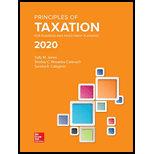
a.
Determine if the given situation amounts to tax avoidance or tax evasion.
a.
Explanation of Solution
Tax Avoidance Vs Tax Evasion: Tax avoidance refers to legalized means of reducing the tax liabilities by the taxpayers through tax planning, on the other hand, illegal means to avoid tax is known as tax evasion which is considered as offence and punishable under law.
In this case, since Mr. L is engaged in concealing his real income and understating it deliberately to avoid tax liability, this would be considered as tax evasion.
b.
Determine if the given situation amounts to tax avoidance or tax evasion.
b.
Explanation of Solution
In this case, since Mr. P did not conceal any of his income rather encourages his son who is with lesser marginal tax rate than him, to invest $50,000, Mr. P is said to be engaged in tax avoidance.
c.
Determine if the given situation amounts to tax avoidance or tax evasion.
c.
Explanation of Solution
In this case, since Mr. Q did not reveal truth in reporting his current years’ profit in the previous year just to gain by the lower marginal tax, he is deliberately trying to cheat the authorities by wrong reporting of income and thus, would be considered as tax evasion.
Want to see more full solutions like this?
Chapter 4 Solutions
PRINCIPLES OF TAXATION F/BUS...(LL)
- Can you help me solve this general accounting problem with the correct methodology?arrow_forwardI have been getting the wrong answers for the NVP of the project? The Gilbert Instrument Corporation is considering replacing the wood steamer it currently uses to shape guitar sides. The steamer has 6 years of remaining life. If kept, the steamer will have depreciation expenses of $700 for 5 years and $350 for the sixth year. Its current book value is $3,850, and it can be sold on an Internet auction site for $4,440 at this time. If the old steamer is not replaced, it can be sold for $800 at the end of its useful life. Gilbert is considering purchasing the Side Steamer 3000, a higher-end steamer, which costs $12,300, and has an estimated useful life of 6 years with an estimated salvage value of $1,200. This steamer falls into the MACRS 5-years class, so the applicable depreciation rates are 20.00%, 32.00%, 19.20%, 11.52%, 11.52%, and 5.76%. The new steamer is faster and allows for an output expansion, so sales would rise by $2,000 per year; the new machine's much greater efficiency…arrow_forwardBrighton Audio produces and sells portable speakers. Each speaker sells for $45, and the variable cost per unit is $28. The company's fixed costs are $60,000, and it expects to sell 5,000 units. What is the contribution margin per unit?arrow_forward
- Can you solve this general accounting problem using accurate calculation methods?arrow_forwardSales reported on the income statement were $310,500. The accounts receivable balance declined by $18,700 over the year. Determine the amount of cash received from customers.arrow_forwardHow much is the labor rate variance?arrow_forward
 Individual Income TaxesAccountingISBN:9780357109731Author:HoffmanPublisher:CENGAGE LEARNING - CONSIGNMENT
Individual Income TaxesAccountingISBN:9780357109731Author:HoffmanPublisher:CENGAGE LEARNING - CONSIGNMENT





